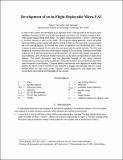Development of an In-Flight-Deployable Micro-UAV
Author(s)
Tao, Toby S.; Hansman, R. John
DownloadST2015 LOCUST rev0F.pdf (1.364Mb)
Metadata
Show full item recordAbstract
A micro-UAV system was developed to be deployed from a host aircraft at normal jet cruise conditions (between 25,000 and 35,000 feet altitude and Mach 0.8) using the standard MJU-10/B countermeasure flare form factor. The system (measuring 49mm × 62mm × 180mm) fits in the flare canister in place of the chaff. The 220-gram battery-powered, pusher-propelled UAV has folding tandem wings with elevon control surfaces on the rear wing. A case protects the UAV during ejection. In freefall, the system is stabilized and decelerated with a drag streamer to approximately 40 m/s, when the case opens and the vehicle unfolds. The UAV was designed to maximize endurance while station-keeping in 30 m/s winds. Estimated level-flight endurance at 30,000 feet carrying a 10-gram payload is 45 minutes with greater endurance at lower altitudes. Up to 45 minutes of glide endurance can be achieved depending on deployment altitude. The small dimensions and low Reynolds number of the wings required manufacturing constraints to be considered in the airfoil design to prevent laminar separation which impacted controllability. Compact folding mechanisms were designed to enable wing folding. An elevon control mechanism was designed to engage automatically with the control surface when the rear wing unfold. Ejection shock, deployment, and flight tests were conducted to demonstrate the feasibility of the concept.
Date issued
2016-02-25Series/Report no.
;AIAA-2016-1742
Keywords
micro-UAV, in-flight deployment, power-system sizing